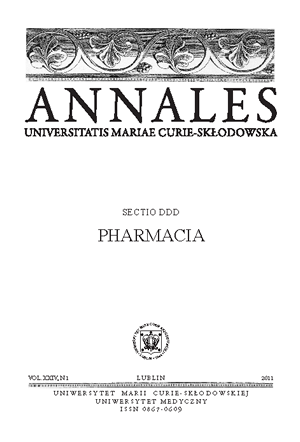The 8-MOP identification and isolation from the plant material and percutaneous permeation in the modified Flynn’s cell
Keywords:
8-MOPAbstract
Xanthotoxin (8-methoxypsoralen, methoxsalen) is a natural furanocoumarin consisting of coumarin annulated with furan. It’s biosynthetic route in plants continues with the activation of dimethylallylpyrophosphate (DMAPP), produced via the mevalonate pathway. Then the carbo-cation is formed via the cleavage of the diphosphates.
References
1. Abdel Hafez O.M., Amin K.M., Abdel-Latif N.A. et al.: Synthesis and antitumor activity of some new xanthotoxin derivatives. Eur. J. Med. Chem., 44, 2967, 2009.
2. Adebajoa A.C., Reisch J.: Minor furocoumarins of Murraya koenigii. Fitoterapia, 71, 334, 2000.
3. Al-Barwani F.M., Eltayeb E.A.: Antifungal compounds from induced Conium maculatum L. plants. Biochem. Syst. Ecol., 32, 1097, 2004.
4. Bhadra D., Bhadra S. et al.: A PEGylated dendritic nanoparticulate carrier of fluorouracil. Int. J. Pharm., 257, 111, 2003.
5. Ceska O., Chaudhary S.K. et al.: Photoactive furocoumarins in fruits of some umbellifers. Phytochem., 26, 165, 1987.
6. Chinou I., Widelski J., Fokialakis N. et al.: Coumarins from Peucedanum luxurian. Fitoterapia, 78, 448, 2007.
7. Dean J.A.: Lange’s Handbook of Chemistry, 14th ed. McGraw-Hill, Inc., New York 1992.
8. Dewick P. M.: Medicinal Natural Products: A Biosynthetic Approach (3rd ed.). John Wiley & Sons. 161, 164, 2009.
9. Ekiert H., Gomółka E.: Coumarins compounds in Ammi majus L. callus cultures. Pharmazie, 55, 684, 2000.
10. Erdelmeier C.A.J., Meier B., Sticher O.: Reserved-phase high-performance liquid chromatographic separation of closely related furanocoumarins. J. Chromat., 346, 456, 1985.
11. Gawdzik J., Kawka S., Mardarowicz M. et al.: Carbon dioxide fractionated supercritical fluid extraction of furanocoumarins from the fruits of Archangelica officinalis Hoffm. Herba Pol., 42, 26, 1996.
12. Govindarajan R., Singh D.P., Singh A.P. et al.: A validated HPLC method for quantification and optimization of furocoumarins in different extracts of fruits of Heracleum candicans. Chromatographia, 66, 401, 2007.
13. Härmäla P., Boltz L., Sticher O., Hiltunen R.: Two-dimensional planar chromatographic separation of a complex mixture of closely related coumarins from genus Angelica. J. Planar Chromatogr., 3, 515, 1990.
14. Hawrył M.A., Soczewiński E., Dzido T.H.: Separation of coumarins from Archangelica officinalis in high-performance liquid chromatography and thin-layer chromatography systems. J. Chromatogr. A, 886, 75, 2000.
15. Kamiński B., Głowniak K., Majewska A. et al.: Poszukiwanie związków kumarynowych w nasionach i owocach. I. Owoce rodziny Baldaszkowatych (Umbelliferae – Apiaceae). Farm. Pol., 34, 25, 1978.
16. Kang J., Zhou L., Sun J. et al.: Chromatographic fingerprint analysis and characterization of furocoumarins in the roots of Angelica dauhurica by HPLC/DAD/ESI-MSn technique. J. Pharm. Biomed. Anal., 47, 778, 2008.
17. Kozyra M., Głowniak K., Zabża A. et al.: Column chromatography and preparative TLC for isolation and purification of coumarins from Peucedanum verticillare L. Koch., J. Planar Chromatogr., 18, 224, 2005.
18. Lauharanta J.: Photochemotherapy. Clin. Dermathol., 15, 769, 1997.
19. Liu R., Lei F., Sun A., Kong L.: Preparative isolation and purification of coumarins from Cnidium monnieri (L.) Cusson by high-speed counter-current chromatography. J. Chromatogr. A, 1055, 71, 2004.
20. Liu Z., Lu Y., Lebwohl M., We H.: PUVA, 8-methoxy-psoralen plus ultraviolet A induces the formation of 8-hydroxy-29-deoxyguanosine and dna ragmentation in calf thymus DNA and human epidermoid carcinoma cells. Free Rad. Biol. Med., 27, 127, 1999.
21. Masuda T., Takasugi M., Anetai M.: Psoralen and other linear furanocoumarins as phytoalexins in Glehnia littoralis. Phytochem., 47, 13, 1998.
22. Milesi S., Massot B., Gontier E. et al.: Ruta graveolens L.: a promising species for the production of furanocoumarins. Plant Sci., 161, 189, 2001.
23. Murphy E.M., Nahar L., Byres M. et al.: Coumarins from the seeds of Angelica silvestris (Apiaceae) and their distribution within the genus Angelica. Biochem. Syst. Ecol., 32, 203, 2004.
24. Nyiredy Sz., Botz L.: Medium-Pressure Solid-Liquid Extraction: A New Preparative Method Based on the Principle of Counter-Current. Chromatographia Supl., 57, 291, 2003.
25. Oliveira F.M., Santana A.G., Conserva L.M. et al.: Alkaloids and coumarins from Esenbeckia species. Phytochem., 41, 2, 647, 1996,
26. Parrish J.A., Fitzpatrick T.B., Tanenbaum L., Pathak M.A.: Photochemotherapy of psoriasis with oral methoxsalen and longwave ultraviolet light. N. Engl. J. Med., 291, 1207, 1974.
27. Pathak M.A., Farrington D., Fitzpatrick T.B.: The presently known distribution of furocoumarins (psoralens) in plants. J. Investig. Dermatol., 39, 225, 1962.
28. Pira E., Romano C., Sulotto F. et al.: Heracleum mantegazzianum growth phases and furocoumarin content. Contact Dermat., 21, 300, 1989.
29. Rai M., Mares D.: Plant-derived antimycotics: current trends and future prospects. Foods Products Press, Binghamton, NY 2003.
30. Sartorelli P., Andersen H.R., Angerer J. et al.: Percutaneous penetration studies for risk assessment. Envir. Toxicol. Pharmacol., 8, 133, 2000.
31. Simon G.A., Maibach H.I.: The pig as an experimental animal model of percutaneous permeation in man: qualitative and quantitative observations—an overview. Skin Pharmacol. Appl. Skin Physiol., 13, 229, 2000.
32. Stevenson P.C., Simmonds M.S.J., Yule M.A. et al.: Insect antifeedant furanocoumarins from Tetradium daniellii Phytochem., 63, 41, 2003.
33. Strzelecka H., Kamińska J., Kowalski J. et al.: Chemiczne metody badań roślinnych surowców leczniczych. PZWL, Warszawa 1987.
34. Trani M., Carbonetti A., Delle Monache G., Delle Monache F.: Dihydrochalcones and coumarins of Esenbeckia grandiflora subsp. Brevipetiolata. Fitoterapia, 75, 99, 2004.
35. Waksmundzka-Hajnos M., Hawrył A.M.: Application of TLC in the isolation and analysis of coumarins. Thin Layer Chromatography in Phytochemistry. CRC, London 2007.
36. Wild S., Aboutabl E.A., Nassar M.I. et al.: Phytochemical and pharmacological studies on Sideritis taurica. J. Ethnopharmacol., 82, 177, 2002.
37. Wolnicka-Głubisz A., Zarębska Z.: PUVA-fotoforeza, fotochemioterapia pozaustrojowa. Przegl. Dermatol., 5, 383, 2003.
38. Wolski T., Najda A., Hołderna-Kędzia E.: Zawartość i skład olejków eterycznych oraz ekstraktów otrzymanych z owoców niektórych roślin z rodziny Umbelliferae (Apiaceae) wraz ze wstępną oceną przeciwbakteryjną ekstraktów. Post. Fitoterapii, 3, 119, 2004.
Downloads
Published
Issue
Section
License
Copyright (c) 2025 Elwira Sieniawska, Joanna Fliszkiewicz, Katarzyna Borowska, Tomasz Baj, Zofia Ulz, Kazimierz Głowniak (Autor)

This work is licensed under a Creative Commons Attribution-NonCommercial-NoDerivatives 3.0 Unported License.


